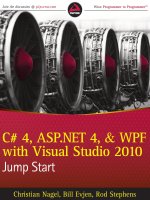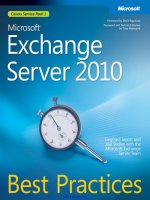Visual studio 2010 best practices
Bạn đang xem bản rút gọn của tài liệu. Xem và tải ngay bản đầy đủ của tài liệu tại đây (3.23 MB, 280 trang )
www.it-ebooks.info
Visual Studio 2010
Best Practices
Learn and implement recommended practices for the
complete software development life cycle with Visual
Studio 2010
Peter Ritchie
BIRMINGHAM - MUMBAI
www.it-ebooks.info
Visual Studio 2010 Best Practices
Copyright © 2012 Packt Publishing
All rights reserved. No part of this book may be reproduced, stored in a retrieval
system, or transmitted in any form or by any means, without the prior written
permission of the publisher, except in the case of brief quotations embedded in
critical articles or reviews.
Every effort has been made in the preparation of this book to ensure the accuracy
of the information presented. However, the information contained in this book is
sold without warranty, either express or implied. Neither the author, nor Packt
Publishing, and its dealers and distributors will be held liable for any damages
caused or alleged to be caused directly or indirectly by this book.
Packt Publishing has endeavored to provide trademark information about all of the
companies and products mentioned in this book by the appropriate use of capitals.
However, Packt Publishing cannot guarantee the accuracy of this information.
First published: August 2012
Production Reference: 1170812
Published by Packt Publishing Ltd.
Livery Place
35 Livery Street
Birmingham B3 2PB, UK.
ISBN 978-1-84968-716-4
www.packtpub.com
Cover Image by Sandeep Babu ()
www.it-ebooks.info
Credits
Author
Project Coordinator
Peter Ritchie
Joel Goveya
Reviewers
Proofreader
Ognjen Bajic
Joel T. Johnson
Carlos Hulot
Indexer
Ahmed Ilyas
Rekha Nair
Ken Tucker
Graphics
Acquisition Editor
Valentina D,silva
Rashmi Phadnis
Manu Joseph
Lead Technical Editor
Dayan Hyames
Production Coordinators
Aparna Bhagat
Nitesh Thakur
Technical Editors
Manmeet Singh Vasir
Cover Work
Merin Jose
Manasi Poonthottam
Aparna Bhagat
Nitesh Thakur
www.it-ebooks.info
About the Author
Peter Ritchie is a software development consultant. He is the president of Peter
Ritchie Inc. Software Consulting Co., a software consulting company in Canada,s
National Capital Region, which specializes in Windows-based software development
management, process, and implementation consulting.
Peter has worked with clients such as Mitel, Nortel, Passport Canada, and Innvapost,
from mentoring, to architecture, to implementation. He has considerable experience
in building software development teams and working with startups towards agile
software development. Peter,s experience ranges from designing and implementing
simple stand-alone applications, to architecting n-tier applications spanning dozens
of computers, and from C++ to C#.
Peter is active in the software development community, attending and speaking
at various events, as well as authoring various works including Refactoring with
Microsoft Visual Studio 2010, Packt Publishing.
There are countless number of people that have contributed to my
knowledge and motivation to contribute to the community with
projects like this book. In particular, I would like to thank Joe Miller
for his sharp eyes and having clearly better editing abilities than mine.
I would also like to thank my wife Sherry for the continued love
and support despite all the extra time I had to put into projects like
book writing.
I would also like to thank my parents, Helen and Bruce; I still
miss you.
www.it-ebooks.info
About the Reviewers
Carlos Hulot has been working in the IT area for more than 20 years in
different capabilities, from software development, project management, to
IT marketing, product development, and management. He has worked for
multinational companies such as Royal Philips Electronics, Pricewaterhouse
Coopers, and Microsoft.
Carlos currently works as an independent IT consultant. He is also a Computer
Science lecturer at two Brazilian universities. Carlos holds a Ph.D. in Computer
Science and Electronics from the University of Southampton, UK and a B.Sc. in
Physics from University of São Paulo, Brazil.
Ahmed Ilyas has a BEng degree from Napier University in Edinburgh, Scotland,
having majored in Software development. He has 15 years of professional experience
in software development.
After leaving Microsoft, Ahmed ventured into setting up his consultancy
company Sandler Ltd. (UK), offering the best possible solutions for a magnitude
of industries, and providing real-world answers to those problems. The company
uses the Microsoft stack to build these technologies. Being able to bring in the best
practices, patterns, and software to its client base for enabling long term stability
and compliance in the ever changing software industry, pushing the limits in
technology, as well as improving software developers around the globe.
Ahmed has been awarded the MVP in C# by Microsoft three times, for providing
excellence and independent real-world solutions to problems that developers face.
Ahmed,s breadth and depth of knowledge has been obtained from his research
and from the valuable wealth of information and research at Microsoft. By knowing
the fact that 90 percent of the world uses at least one form of Microsoft technology,
motivates and inspires him.
www.it-ebooks.info
Ahmed has worked for a number of clients and employers. With the great reputation
that he has, it has resulted in having a large client base for his consultancy company,
which includes clients from different industries. From media to medical and beyond.
Some clients have included him on their "approved contractors/consultants" list.
The list includes ICS Solution Ltd. (placed on their DreamTeam portal) and also EPS
Software Corp. (based in the USA).
I would like to thank the author and the publisher for giving me the
opportunity to review this book. I would also like to thank my client
base and especially my colleagues at Microsoft for enabling me to
become a reputable leader as a software developer in the industry,
which is my passion.
Ken Tucker is a Microsoft MVP (2003–present) in Visual Basic and currently
works at Amovius LLC in Melbourne, Florida (FL). He is also the President of
the Space Coast .Net User Group and a frequent speaker at Florida Code Camps.
Ken be reached at
I'd like to thank my wife Alice-Marie.
www.it-ebooks.info
www.PacktPub.com
Support files, eBooks, discount offers and more
You might want to visit www.PacktPub.com for support files and downloads
related to your book.
Did you know that Packt offers eBook versions of every book published, with PDF and ePub
files available? You can upgrade to the eBook version at www.PacktPub.com and as a print
book customer, you are entitled to a discount on the eBook copy. Get in touch with us at
for more details.
At www.PacktPub.com, you can also read a collection of free technical articles, sign up
for a range of free newsletters and receive exclusive discounts and offers on Packt books
and eBooks.
Do you need instant solutions to your IT questions? PacktLib is Packt,s online digital
book library. Here, you can access, read and search across Packt,s entire library of books.
Why Subscribe?
•
Fully searchable across every book published by Packt
•
Copy and paste, print and bookmark content
•
On demand and accessible via web browser
Free Access for Packt account holders
If you have an account with Packt at www.PacktPub.com, you can use this to access
PacktLib today and view nine entirely free books. Simply use your login credentials
for immediate access.
Instant Updates on New Packt Books
Get notified! Find out when new books are published by following @PacktEnterprise
on Twitter, or the Packt Enterprise Facebook page.
www.it-ebooks.info
www.it-ebooks.info
Table of Contents
Preface1
Chapter 1: Working with Best Practices
7
Recommended practices
Intransitive "best" practices
Benefits of using practices
Avoiding pragmatic re-use
Reducing technical debt
Not invented here syndrome
Beyond practices
Using katas
Reaching kaizen
Aspects of a practice
Evaluating practices
Documenting practices
7
9
10
11
11
12
13
13
14
15
15
16
Evolving practices—a collaborative effort
Axiomatic practices
Patterns
Why practices?
22
23
23
23
Geographic distribution
16
17
Team size
Regulatory compliance
17
Domain complexity
17
Organizational distribution
17
Technical complexity
17
Organizational complexity
18
Enterprise discipline
18
Life-cycle scope
18
Paradigm18
Categorization19
In this book
22
www.it-ebooks.info
Table of Contents
An empirical and not a defined process
Cross-cutting concerns
Focus on the value
The power of mantras
Summary
Chapter 2: Source Code Control Practices
24
25
25
25
26
29
Terminology
30
Repository30
SCC30
Edit/merge/commit30
Lock/edit/check-in30
Trunk31
Branch31
Fork31
Merge31
Check-out31
Check-in32
Changeset32
Lock32
Commit32
Push32
Pull32
Tag/label33
Shelving/shelvesets33
Principles
33
Recommended SCC software evaluation criteria
34
Workflow model
35
Total cost of ownership
35
Integration options
35
Team dynamics and location
36
Self or third-party hosting
36
Authentication36
Organizing for source code control
36
Organizing directory structures
37
Solution structure
39
Continuous integration
40
Branching strategies
41
Isolation41
Ad hoc isolation
42
Testing isolation
42
[ ii ]
www.it-ebooks.info
Table of Contents
Release isolation
Feature isolation
Team isolation
Commit (check-in) practices
Merge remote changes before commit
Commit frequently
Atomic commits
Occasionally connected source control
Distributed source control
Summary
43
44
45
46
46
46
47
48
48
49
Chapter 3: Low-level C# Practices
51
Chapter 4: Architectural Practices
75
Working with generics
Limits of generics
Writing sequence and iterator members
Working with lambdas
Working with extension methods
Exception handling
Exceptions to the exception practices
Summary
51
52
52
54
57
61
71
73
Terms
75
Decoupling
76
Command Query Separation
76
Data Transfer Objects (DTO)
78
Single responsibility
79
Layering80
Data-based applications
81
Object Relational Mappers (ORMs)
82
NoSQL86
Document databases
87
Pulling it all together
88
Distributed architecture
89
Messaging91
Data synchronization and events
92
DTOs Revisited
93
Summary
Chapter 5: Recommended Practices for Deployment
93
95
Working with installers
96
Working with Windows Installer
96
Uninstalling97
[ iii ]
www.it-ebooks.info
Table of Contents
Visual Studio Setup and Deployment projects
Setup Wizard
Setup Project
Web Setup Project
Merge Module Project
CAB Project
File System
File types
User interface
Launch conditions
98
98
99
99
100
100
101
102
102
102
Custom actions
103
Drawbacks of Setup and Deployment Project
103
ClickOnce
103
Windows Installer XML (WiX)
104
Include files
107
Fragments108
Migrating from Setup and Deployment projects
109
Integrating into Visual Studio
110
Setup Project
Merge Module Project
Setup Library Project
Bootstrapper Project
C# Custom Action Project
C++ Custom Action Project
110
112
112
113
114
115
Continuous integration
Silent installations
Testing
Summary
Chapter 6: Automated Testing Practices
First principles
Related terms
Test-driven development
Red, Green, Refactor
I'm not a tester
115
116
117
119
121
121
122
122
123
123
Why automated?
Benefits
124
124
Aspects of good tests
126
Continuous verification
125
Documentation125
Caveats125
Repeatable126
Independent126
126
Verifies one thing
Simple127
[ iv ]
www.it-ebooks.info
Table of Contents
Readable127
Fast127
Reliable128
Informative128
Test naming
Separate test projects or not?
Test styles
Arrange, Act, Assert
Given, When, Then
Test types
128
130
130
130
135
138
State-based testing
Interaction testing
138
139
Object-orientation and tests
140
Fluent interfaces revisited
141
Mocking
143
Isolation frameworks
144
Methodologies
144
TDD144
BDD146
Test coverage
147
Continuous testing
147
Round-tripping requirements and acceptance
148
Summary
150
Chapter 7: Optimizing Visual Studio
Visual Studio efficiency through configuration
Recommended computer specifications
151
151
151
Multi-monitor152
Organizing projects
Organizing windows
154
156
Auto-hiding157
Toolbars158
Exceptional features
158
Exporting/backing up your custom look and feel
159
Add-ins and extensions
161
Productivity Power Tools
161
Resharper163
Visual Studio efficiency through usage
164
Using the keyboard over the mouse
164
Dividing up solutions
165
Macros165
Advanced search/replace
Playing nice with source code control
Tracked file in project/solution
[v]
www.it-ebooks.info
166
167
168
Table of Contents
Continuous integration
169
Tests169
Build169
Summary
Chapter 8: Parallelization Practices
Principles
Threading primitives
Threading caveats
Other terminologies
Threads
Thread synchronization
Thread safety
Minding your invariants
Thread synchronization and locking
171
173
174
175
175
177
178
179
179
180
181
Locking181
Lock-free synchronization
182
Advanced synchronization
184
Asynchronous operations
186
Asynchronous Design Pattern
187
Event-based Asynchronous Pattern
190
Division of labor
191
Task Parallel Library
194
Tasks195
Execution195
Parallelization196
Working with Asynchronous Design Pattern
198
Continuations199
Visual Studio 2012 asynchronous programming
200
The Task-based Asynchronous Pattern
201
Reactive Extensions
202
Summary
204
Chapter 9: Distributed Applications
Seeking scalability
Design options
Communicating via a database
Messaging pattern
Message queues
Command-query separation
Message bus
Service bus
205
206
206
206
207
208
209
210
210
Cloud
Infrastructure as a Service
211
212
[ vi ]
www.it-ebooks.info
Table of Contents
Platform as a Service
Software as a Service
TCP/UDP
Debugging
Logging
What to log
Health monitoring
Proactive monitoring
Summary
Chapter 10: Web Service Recommended Practices
212
212
214
214
215
219
224
225
226
227
Implementing WCF services
229
Editing configuration
229
Hosting232
Hosting WCF services in IIS
Windows service WCF self-hosting
WCF self-hosted
234
236
237
Manual testing
Authentication and authorization
Different transport options
ASP.NET Web Services
Authentication and authorization
Summary
238
240
243
244
244
249
Index
251
[ vii ]
www.it-ebooks.info
www.it-ebooks.info
Preface
When you are developing on the Microsoft platform, Visual Studio 2010
offers you a range of powerful tools and makes the entire process easier and
faster. After learning it, if you think that you can sit back and relax, you cannot
be further away from truth. To beat the crowd, you need to be better than others,
learn tips and tricks that other don’t know yet. This book is a compilation of the
best practices of programming with Visual Studio.
Visual Studio 2010 Best Practices will take you through the practices you need
to master programming with the .NET Framework. The book goes on to detail
several practices involving many aspects of software development with Visual
Studio. These practices include debugging, exception handling, and design. It
details building and maintaining a recommended practices library and the
criteria by which to document recommended practices.
The book begins with practices on source code control (SCC). It includes
different types of SCC and discusses how to choose them based on different
scenarios. Advanced syntax in C# is then covered with practices covering
generics, iterator methods, lambdas, and closures.
The next set of practices focus on deployment, as well as creating MSI
deployments with Windows Installer XML (WiX), including Windows
applications and services. The book then takes you through practices for
developing with WCF and Web Service.
The software development lifecycle is completed with practices on testing, such as
project structure, naming, and the different types of automated tests. Topics such
as test coverage, continuous testing and deployment, and mocking are included.
Although this book uses Visual Studio as an example, you can use these practices
with any IDE.
www.it-ebooks.info
Preface
What this book covers
Chapter 1, Working with Best Practices, discusses several motivating factors about
why we might want to use "recommended practices" and why we’re sometimes
forced to resort to "recommended practices" rather than figure it out.
Chapter 2, Source Code Control Practices, looks at source code control terminology,
architectures, and usage practices.
Chapter 3, Low-level C# Practices, looks at some low-level, language-specific practices.
Topics like generics, lambdas, iterator members, extension methods, and exception
handling will be detailed.
Chapter 4, Architectural Practices, looks at some architecture-specific practices.
These practices will include things such as decoupling, data-centric applications,
and a brief look at some recommendations for distributed architectures.
Chapter 5, Recommended Practices for Deployment, discusses installation technologies
and covers some of the more common features required by the majority application
installations. The chapter focuses mainly on deployment of applications through
Windows Installer
Chapter 6, Automated Testing Practices, covers automated testing practices. Practices
regarding test naming and structure, coverage, mocking, and types of tests will
be covered.
Chapter 7, Optimizing Visual Studio, discusses ways of making Visual Studio operate
more efficiently, work to our advantage, and ways to make working with Visual
Studio friendlier.
Chapter 8, Parallelization Practices, discusses techniques such as threading,
distributed architecture, and thread synchronization. Technologies such as
Task Parallel Library, Asynchronous CTP, and asynchronous additions to
C# 5.0 and Visual Basic 10 are also covered.
Chapter 9, Distributed Applications, discusses ways of architecting distributed
applications, as well as specific technologies that help communication of nodes
within a distributed application. In addition, it covers ways of debugging,
monitoring, and maintaining distributed applications.
Chapter 10, Web Service Recommended Practices, discusses web services. It covers
practices with WCF services, ASMX services, implementing services, consuming
services, and authentication and authorization.
[2]
www.it-ebooks.info
Preface
What you need for this book
•
Visual Studio 2010 Express (Professional recommended) or better
•
Windows XP SP3 or better
•
Optional: NUnit or XUnit
Who this book is for
.NET developers using Visual Studio for programming will find this book useful.
If you are developing your application with C#, you will find better ways to do
things with Visual Studio.
You should know basics of development with the .NET Framework and will need
working knowledge on Visual Studio.
Conventions
In this book, you will find a number of styles of text that distinguish between
different kinds of information. Here are some examples of these styles, and
an explanation of their meaning.
Code words in text are shown as follows: "The Iterator method returns
IEnumerable that results in three DateTime values."
A block of code is set as follows:
public static IEnumerable<DateTime> Iterator()
{
Thread.Sleep(1000);
yield return DateTime.Now;
Thread.Sleep(1000);
yield return DateTime.Now;
Thread.Sleep(1000);
yield return DateTime.Now;
}
When we wish to draw your attention to a particular part of a code block,
the relevant lines or items are set in bold:
namespace ConsoleApplication
{
using Numerical;
internal class Program
{
[3]
www.it-ebooks.info









